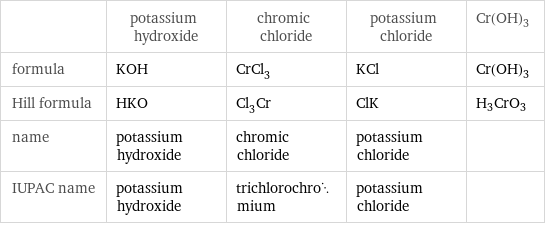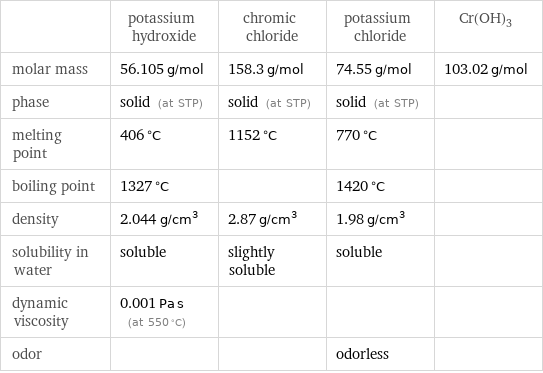Input interpretation

KOH potassium hydroxide + CrCl_3 chromic chloride ⟶ KCl potassium chloride + Cr(OH)3
Balanced equation

Balance the chemical equation algebraically: KOH + CrCl_3 ⟶ KCl + Cr(OH)3 Add stoichiometric coefficients, c_i, to the reactants and products: c_1 KOH + c_2 CrCl_3 ⟶ c_3 KCl + c_4 Cr(OH)3 Set the number of atoms in the reactants equal to the number of atoms in the products for H, K, O, Cl and Cr: H: | c_1 = 3 c_4 K: | c_1 = c_3 O: | c_1 = 3 c_4 Cl: | 3 c_2 = c_3 Cr: | c_2 = c_4 Since the coefficients are relative quantities and underdetermined, choose a coefficient to set arbitrarily. To keep the coefficients small, the arbitrary value is ordinarily one. For instance, set c_2 = 1 and solve the system of equations for the remaining coefficients: c_1 = 3 c_2 = 1 c_3 = 3 c_4 = 1 Substitute the coefficients into the chemical reaction to obtain the balanced equation: Answer: | | 3 KOH + CrCl_3 ⟶ 3 KCl + Cr(OH)3
Structures

+ ⟶ + Cr(OH)3
Names

potassium hydroxide + chromic chloride ⟶ potassium chloride + Cr(OH)3
Equilibrium constant
![Construct the equilibrium constant, K, expression for: KOH + CrCl_3 ⟶ KCl + Cr(OH)3 Plan: • Balance the chemical equation. • Determine the stoichiometric numbers. • Assemble the activity expression for each chemical species. • Use the activity expressions to build the equilibrium constant expression. Write the balanced chemical equation: 3 KOH + CrCl_3 ⟶ 3 KCl + Cr(OH)3 Assign stoichiometric numbers, ν_i, using the stoichiometric coefficients, c_i, from the balanced chemical equation in the following manner: ν_i = -c_i for reactants and ν_i = c_i for products: chemical species | c_i | ν_i KOH | 3 | -3 CrCl_3 | 1 | -1 KCl | 3 | 3 Cr(OH)3 | 1 | 1 Assemble the activity expressions accounting for the state of matter and ν_i: chemical species | c_i | ν_i | activity expression KOH | 3 | -3 | ([KOH])^(-3) CrCl_3 | 1 | -1 | ([CrCl3])^(-1) KCl | 3 | 3 | ([KCl])^3 Cr(OH)3 | 1 | 1 | [Cr(OH)3] The equilibrium constant symbol in the concentration basis is: K_c Mulitply the activity expressions to arrive at the K_c expression: Answer: | | K_c = ([KOH])^(-3) ([CrCl3])^(-1) ([KCl])^3 [Cr(OH)3] = (([KCl])^3 [Cr(OH)3])/(([KOH])^3 [CrCl3])](../image_source/49fcbd79e26a7d82d36c700d9ad9c281.png)
Construct the equilibrium constant, K, expression for: KOH + CrCl_3 ⟶ KCl + Cr(OH)3 Plan: • Balance the chemical equation. • Determine the stoichiometric numbers. • Assemble the activity expression for each chemical species. • Use the activity expressions to build the equilibrium constant expression. Write the balanced chemical equation: 3 KOH + CrCl_3 ⟶ 3 KCl + Cr(OH)3 Assign stoichiometric numbers, ν_i, using the stoichiometric coefficients, c_i, from the balanced chemical equation in the following manner: ν_i = -c_i for reactants and ν_i = c_i for products: chemical species | c_i | ν_i KOH | 3 | -3 CrCl_3 | 1 | -1 KCl | 3 | 3 Cr(OH)3 | 1 | 1 Assemble the activity expressions accounting for the state of matter and ν_i: chemical species | c_i | ν_i | activity expression KOH | 3 | -3 | ([KOH])^(-3) CrCl_3 | 1 | -1 | ([CrCl3])^(-1) KCl | 3 | 3 | ([KCl])^3 Cr(OH)3 | 1 | 1 | [Cr(OH)3] The equilibrium constant symbol in the concentration basis is: K_c Mulitply the activity expressions to arrive at the K_c expression: Answer: | | K_c = ([KOH])^(-3) ([CrCl3])^(-1) ([KCl])^3 [Cr(OH)3] = (([KCl])^3 [Cr(OH)3])/(([KOH])^3 [CrCl3])
Rate of reaction
![Construct the rate of reaction expression for: KOH + CrCl_3 ⟶ KCl + Cr(OH)3 Plan: • Balance the chemical equation. • Determine the stoichiometric numbers. • Assemble the rate term for each chemical species. • Write the rate of reaction expression. Write the balanced chemical equation: 3 KOH + CrCl_3 ⟶ 3 KCl + Cr(OH)3 Assign stoichiometric numbers, ν_i, using the stoichiometric coefficients, c_i, from the balanced chemical equation in the following manner: ν_i = -c_i for reactants and ν_i = c_i for products: chemical species | c_i | ν_i KOH | 3 | -3 CrCl_3 | 1 | -1 KCl | 3 | 3 Cr(OH)3 | 1 | 1 The rate term for each chemical species, B_i, is 1/ν_i(Δ[B_i])/(Δt) where [B_i] is the amount concentration and t is time: chemical species | c_i | ν_i | rate term KOH | 3 | -3 | -1/3 (Δ[KOH])/(Δt) CrCl_3 | 1 | -1 | -(Δ[CrCl3])/(Δt) KCl | 3 | 3 | 1/3 (Δ[KCl])/(Δt) Cr(OH)3 | 1 | 1 | (Δ[Cr(OH)3])/(Δt) (for infinitesimal rate of change, replace Δ with d) Set the rate terms equal to each other to arrive at the rate expression: Answer: | | rate = -1/3 (Δ[KOH])/(Δt) = -(Δ[CrCl3])/(Δt) = 1/3 (Δ[KCl])/(Δt) = (Δ[Cr(OH)3])/(Δt) (assuming constant volume and no accumulation of intermediates or side products)](../image_source/373a3e72bf6217c86bd2f07db316806f.png)
Construct the rate of reaction expression for: KOH + CrCl_3 ⟶ KCl + Cr(OH)3 Plan: • Balance the chemical equation. • Determine the stoichiometric numbers. • Assemble the rate term for each chemical species. • Write the rate of reaction expression. Write the balanced chemical equation: 3 KOH + CrCl_3 ⟶ 3 KCl + Cr(OH)3 Assign stoichiometric numbers, ν_i, using the stoichiometric coefficients, c_i, from the balanced chemical equation in the following manner: ν_i = -c_i for reactants and ν_i = c_i for products: chemical species | c_i | ν_i KOH | 3 | -3 CrCl_3 | 1 | -1 KCl | 3 | 3 Cr(OH)3 | 1 | 1 The rate term for each chemical species, B_i, is 1/ν_i(Δ[B_i])/(Δt) where [B_i] is the amount concentration and t is time: chemical species | c_i | ν_i | rate term KOH | 3 | -3 | -1/3 (Δ[KOH])/(Δt) CrCl_3 | 1 | -1 | -(Δ[CrCl3])/(Δt) KCl | 3 | 3 | 1/3 (Δ[KCl])/(Δt) Cr(OH)3 | 1 | 1 | (Δ[Cr(OH)3])/(Δt) (for infinitesimal rate of change, replace Δ with d) Set the rate terms equal to each other to arrive at the rate expression: Answer: | | rate = -1/3 (Δ[KOH])/(Δt) = -(Δ[CrCl3])/(Δt) = 1/3 (Δ[KCl])/(Δt) = (Δ[Cr(OH)3])/(Δt) (assuming constant volume and no accumulation of intermediates or side products)
Chemical names and formulas

| potassium hydroxide | chromic chloride | potassium chloride | Cr(OH)3 formula | KOH | CrCl_3 | KCl | Cr(OH)3 Hill formula | HKO | Cl_3Cr | ClK | H3CrO3 name | potassium hydroxide | chromic chloride | potassium chloride | IUPAC name | potassium hydroxide | trichlorochromium | potassium chloride |
Substance properties

| potassium hydroxide | chromic chloride | potassium chloride | Cr(OH)3 molar mass | 56.105 g/mol | 158.3 g/mol | 74.55 g/mol | 103.02 g/mol phase | solid (at STP) | solid (at STP) | solid (at STP) | melting point | 406 °C | 1152 °C | 770 °C | boiling point | 1327 °C | | 1420 °C | density | 2.044 g/cm^3 | 2.87 g/cm^3 | 1.98 g/cm^3 | solubility in water | soluble | slightly soluble | soluble | dynamic viscosity | 0.001 Pa s (at 550 °C) | | | odor | | | odorless |
Units
